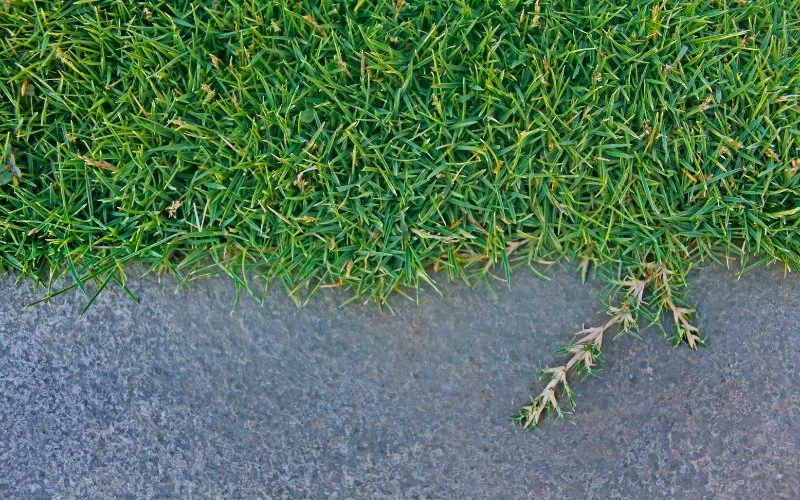Torpedo grass is a weed that produces sharp, strong rhizomes that can quickly spread throughout a lawn and begin to strangle any plant life within. These rhizomes can poke through a thick layer of gravel, colonize landscape fabric in days, and may even pierce through tree roots.
In a Bermuda grass lawn, Torpedo grass can be a little trickier to identify given how similar the early appearance of Torpedo grass is to established clumps of Bermuda grass. However, there are several specific symptoms of Torpedo grass infestation that are hard to miss.
How to Spot Torpedo Grass in a Bermuda Lawn
There are 3 primary, overarching signs of torpedo grass infesting or beginning to grow within a Bermuda lawn.
Uneven Grass Texture and Interrupted Spacing
Uneven texture can be the easiest sign to spot. While Bermuda grass is relatively low-growing and is comprised of grass “cores” spaced only about 6 inches apart with blades of grass springing up from stolons lain between these “cores”, Torpedo grass grows differently. Torpedo grass grows upward more than outward, with underground roots called rhizomes sending up what may, when compared to Bermuda grass blades, look like towers of many interlocked blades of grass.
Bermuda grass spreads out quickly but does not grow upwards as fast as Torpedo grass will. Further, Torpedo grass sends out rhizomes that set up these “towers” at intervals of 8 to 12″ between primary “towers” or nodes. This makes the yard look uneven as the grass is growing in different ways at different rates.
Grass Growing Through Barriers and “Attacking” Landscape Plants
Bermuda grass is relatively “polite” as far as warm-season grasses go. It doesn’t take up more than it needs and it’s not as aggressive as St. Augustine or Zoysiagrass. When grown alongside flower beds with only thick mulch, light plastic, or landscape fabric as a barrier, Bermuda grass will likely behave and rarely try to enter these spaces. Torpedo grass is different.
Torpedo grass will quickly invade any space and can “Torpedo” through nearly any weed barrier that’s not thick stone or steel. It will even work through the roots of established landscape plants and deep mulch, including gravel. This not only makes it harder to remove with any method, but it also makes it easy to identify just what type of weed is invading your lawn.
“Folded” Blades of Grass
Though Torpedo grass looks a lot like Bermuda grass while it is cut low, it will begin to take on a different shape if it’s left to grow up to 3 inches or so. At this point, the Torpedo grass will have developed more than one full set of blades on each stem, leading to a “folded” or upright, joined appearance.
The blades of grass may look like they have a slight bend or curve in the center, contrasting with the flat, broad blades of Bermuda grass. Allowing the grass to grow up, if it’s thick, can make the Torpedo grass harder to pick out but if the lawn is thinning, this can be a good way to be sure of what you’re dealing with.
Torpedo Grass vs Bermuda Grass: Similarities
When you’re dealing with a potential Torpedo grass infestation in a Bermuda grass lawn, it’s just as important to realize what the two grass types have in common as to know what they don’t. This can help ensure that you know you’re dealing with Torpedo grass rather than another type of invasive, grass-like weed. It can also ensure that you don’t accidentally start removing your Bermuda grass even if it’s entwined with the Torpedo grass.
Hairs on Blades of Grass
Both Torpedo and Bermuda grass have small hairs on the leaf-sheath portions of each blade of grass, whether that blade comes from a rhizome of a stolon. However, these hairs will stop forming on the upper section of Bermuda grass blades. This is not true for Torpedo grass.
Grass Growing Out of Rhizomes
Both Torpedo grass and Bermuda will grow blades of grass from their rhizomes. However, Torpedo grass grows from rhizomes nearly all of the time while Bermuda grass grows from rhizomes rarely.
Medium to Dark Green Grass Color
It would be nice if Torpedo vs Bermuda grass identification came down to something easy like color. However, both Torpedo and Bermuda are likely to be a nice medium to dark green, if they’re healthy.
Torpedo Grass vs Bermuda Grass: Differences
This is how you know where your Torpedo grass problem begins and ends. These are the 4 main things that visually separate Bermuda grass from Torpedo grass.
A Lack of Stolons
Stolons are the “above ground roots” that Bermuda grass plants send out into nearby patches of soil to create new nodes or cores of grass. Once they reach between two nodes, several blades of grass will spring up from each stolon. Over time, this creates a Bermuda grass lawn. Bermuda grass can also grow from rhizomes, but this is far less likely.
If your lawn is infested with Torpedo grass patches, these patches will have a notable lack of stolons. It is very rare that Torpedo grass will create stolons, though not impossible. Instead, Torpedo grass generally spreads through the use of pointed, “torpedo-like” rhizomes. These grow under the ground and send up blades of grass from beneath the soil while the rhizomes remain hidden.
Hairs on Upper Section of Grass Blades
While both plants have hairs on them, the hairs on Torpedo grass will appear farther up the plant than they will on blades of Bermuda grass. With Bermuda grass, these hairs are only found on and around the leaf sheath.
Upward, Patchy Growth vs Low, Close-Knit Growth
With Torpedo grass, you end up with lone tower-like nodes that grow up quickly but that don’t tend to mesh well together. With Bermuda grass, the stolons each node produces will knit over each other and create a lawn. If you’re not seeing this “knitting”, you may have a large patch of Torpedo grass.
Grass Blade Shape and Style
Bermuda grass blades are broad, flat, and just a little coarse. Torpedo grass blades are like this while they’re small but as they mature, each blade will end up with a small crease or bend in the center.



Leave a Reply